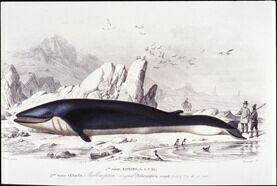| Wilhelm
GŁterwagen was already the most renowned
biologist/gourmand around by the age of thirty, so his
celebrated arctic expeditions received front-page
coverage in the world's press. Making good on his
announcement that he would fearlessly travel where no man
had gone before, he and his small staff explored the
polar ice cap off North America led by Inuit guides; off
Europe led by Lapps, and (due to contractual clauses
attached to his underwriting), off Asia led by a select
committee of the Valparaiso Indiana Chamber of
Commerce.
Perhaps the most unusual find of the Expeditions was the discovery, living on the polar ice cap, of a live specimen of the heretofore legendary Blue Ice Whale, known to the Inuit for its ability to stay alive and unfrozen in the frigid air as it slid over the ice and foraged for plankton, but dismissed by Science as the naive tales of a people silly enough to have 72 hypothermia but no words at all for codependency. Initially wary of the whale, the expedition soon realized that the huge creature was a gentle giant which showed no sign of agitation as the scientist's crew examined it. |
|||
| One crewman was tragically crushed when the whale moved, but all witnesses agreed that it was an accident, and that the whale appeared contrite and made a meeping noise that was "almost certainly an apology." |  "It always appeared to be smiling," wrote GŁterwagen. "But we could never induce it to jump through a hoop or anything." |
||
| Nevertheless, as food
supplies had began to run low, many crewmen wanted to
kill the creature for its meat, but GŁterwagen rejected
this proposal as his religion's complicated dietary laws
forbade the consumption of any mammalian species unless
it had "shapely
ankles".
The very next morning, it was discovered that the whale had slipped away during the night. GŁterwagen's reports brought many other expeditions out looking for the Blue Ice Whale, but no other specimens have been found. |
|||


